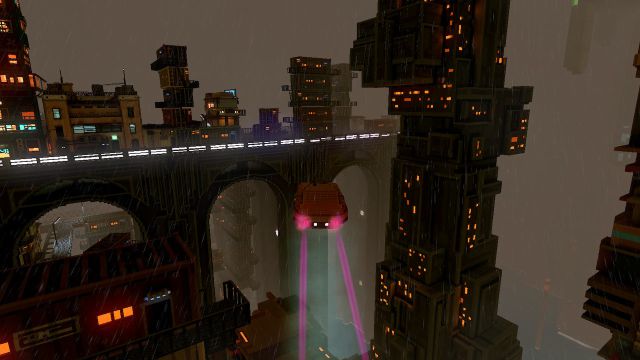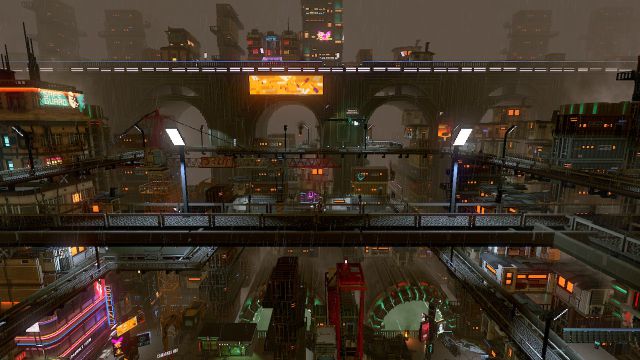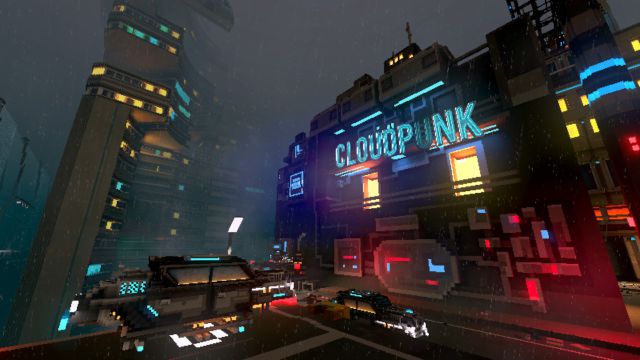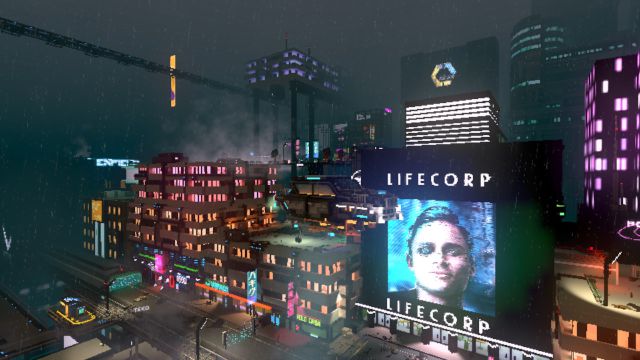
Millions of people stroll through Night City in a daze. We immerse ourselves in another city less luxurious than that of Cyberpunk 2077 but equally hypnotic and captivating, the Nivalis of Cloudpunk
In the open worlds, if there is something that has always been criticized, it has been the messenger missions. You talk to a character, he gives you something to take from A to B, you make the delivery at the destination and back to the start to collect the fees. This resource so handy in sandboxes is usually implemented to fill the gaps in the main narrative and thus extend the overall game experience. It also ensures that we kick the map from one side to another, that for something the developers have invested an indecent amount of work hours lifting a world.
The reviled messenger missions are the impasse between two interesting moments, the television advertising that interrupts the film at the wrong time, the time-outs that break the rhythm of the game, the yawn from the routine before something happens in your life minimally interesting. How is it possible that a game that has this type of mission as its main mechanic does not kill us with boredom and, on the contrary, is able to keep us hooked from beginning to end? Welcome to Cloudpunk and its unlikely narrative.
A megalopolis built on a raging sea by stacking voxels, as if Minecraft were dark and ornate rather than colorful and minimal. We travel in our hovercraft through the eternal night under an eternal rain. We gracefully dodge the black skyscrapers edged with big neon signs while cursing the busy traffic. We are Rania, an inhabitant of the rural areas of the Eastern Peninsula, recently arrived in a city that is only solid and imposing in appearance. Nivalis stands tall with duct tape and hope, says an engineer defeated by an impossible task. There has come a time when the lives I save by fixing something are the same ones that are lost precisely by fixing it.
Cloudpunk, developed by Ion Lands (perfect name to accompany a game like this in the credits), shows us the usual cyberpunk discourse: large corporations, an environment that is also a leading character, classic film noir tints and even blacker writing, uprooted characters who in turn unintentionally sink their roots in a city that devours its children; absence of natural light in favor of fluorescent and neon, music of long synthesized notes indebted to Vangelis; artificial intelligences as new gods, capitalism and social inequality at its best, street trades of artificial skin and the latest in synthetic drugs. Newspeak that assimilates a population made up of human beings with cybernetic implants and androids fighting for a place in that sick society, all debtors of literary minds like Gibson’s or Sterling’s.

The sky over the harbor was the color of a television screen tuned to a dead channel.
The mythical phrase that opens Neuromancer (William Gibson, 1984), the pillar novel of the Cyberpunk movement, already gives full prominence to the environment, to the city. There Rania, that worker who has just arrived at Cloudpunk, a messaging agency that moves within the limits of legality, only hears the echoes of the great cybernetic exploits. Their mission is much more banal: deliver packages without asking questions.
In the prologue of the comic version of Neuromancer (Tom de Haven, Bruce Jensen, 1989), Jacinto Antón tells us an anecdote that Gibson himself told him (although it changes in nuances in Wikipedia, we take as a basis what was published in this prologue 1989 firsthand by Jacinto since, basically, they coincide in the essentials). William Gibson, after a complex and exhausting process of writing what would be his first novel, decided to reward himself with a trip to the cinema to relax. He went into the room that was showing the recently released Blade Runner (Ridley Scott, 1982) … And came out horrified. The insecurity that had accompanied him throughout the arduous writing of Neuromancer reached its zenith in that epiphany. In the words of Jacinto, Gibson “thought that everyone would say that he had been inspired by the film.”
We can imagine Gibson’s gaze illuminated in the dark room by that infernal vision of Los Angeles in Blade Runner, observing without blinking, like that great eye that fills the screen in the first bars of the film and that will be a fundamental and recurring element throughout throughout the projection. The power of those images marked from then on a canon on which to build cities in the darkest futurist stories in the following decades. Literature, movies and, of course, video games did. The city of Cloudpunk manifests itself as one of the most faithful representations of that great city from Blade Runner.

Engineer: Everything falls apart. My colleagues speak with artificial intelligences that stopped answering a thousand years ago. Yes, I can go down to the slums and paint the reflection of the sun in the waves as they swallow the city.
Nivalis, which is the largest city on the planet and measures one hundred kilometers wide and one thousand high, expresses itself in the verticality of its skyscrapers in the midst of an incessant rain. Hundred-meter neons cover the facades spitting out their advertising. Corporate logos, informational messages, signs for discos and fast food restaurants, everything is highlighted with the corporeal glow of the best works of Douglas Trumbull, with the eighties vision of the future. Highways of light agglutinate dense traffic, but it is common to hear the sound of sirens echoing in damp, narrow alleys, or to feel how flying cars whistle over the heads of troubled passers-by.
As in Blade Runner and unlike in Androids Dream of Electric Sheep (Philip K. Dick, 1968), the novel on which Ridley Scott’s film is based, the city of Cloudpunk looks and feels alive, overcrowded with pedestrians and garbage. The Kipple (or Kippel), a term coined by Dick in his novel that describes the uselessness that accumulates inside and outside buildings to the point that it is assimilated to them, runs freely in both works, film and video game. The graphics based on the Voxel fully embrace the concept illuminated by Dick. The buildings and streets of Nivalis are riddled with bumps, neglect, countless objects without an owner that hug floors and walls.

Evelin: Last month, the 1875B shuttle to Phobos took off from Terminal B with the bay gates closed.
Accidents happen randomly and unavoidably across Nivalis, taking the lives of dozens of people, everything fails, everything falls apart. The city remains in a delicate balance. Sometimes we see how some buildings collapse and fall out of sheer fatigue, others because of bombs placed by terrorist groups. In the midst of chaos, our insignificant protagonist keeps a certain humor and optimism in her heart, perhaps as the only way not to crumble before the immensity that surrounds her.
Rania moves between skyscrapers in a HOVA, a flying company utility vehicle. Debuts job as a delivery person on a night that is expected to be long. In the trunk, the package to be delivered; for company, Camus, a talking artificial intelligence represented with a photo of a dog. The conversations happen almost without rest, with the AI, but also with a boss who opens his heart as the hours go by and with the clients who come and go on this first day. Little by little and without rest, we are seeing how the narrative is built based on dialogues. There are no stops in the gameplay, everything flows continuously.
Thus, we know that those who suffocate on Earth seek their luck in the Colonies far away, in the stars, where the work is hard but there is also hope for something better. The others survive as best they can on a polluted Earth, piling their misery in giant apartment blocks. Coexistence occurs between humans, but also with AI and androids aware of their existence.

Camus: Swallowed by the seas, whose groans break on thousands of shores (…) We have become death, destroyer of worlds.
Camus, the artificial intelligence integrated into our vehicle, not only shares a name with the French novelist, philosopher and essayist of Algerian origin Albert Camus, but, among submissive comments, he is able to turn to the American physicist Robert Oppenheimer and his quote from an old Hindu poem after the explosion of the atomic bomb on Hiroshima.
And it is that the androids and the AI feel the emptiness beyond their DNA programmed by humans. The Androids Equality Act gave them rights, and while some marry on a whim with the gentry, others are insulted with the term skinny rescued from Blade Runner as they search for skin grafts for their worn faces. In the enormous Anderson Finance tower, two thousand androids named Anderson (one thousand are Mr. Anderson and one thousand Mrs. Anderson) work without ever leaving for a boss, the human Mr. Anderson, who is possibly long dead. Among tons of telematics bureaucracy, some have already begun to peer curiously beyond their office windows. Down in the streets, short-circuited androids roam in search of lost memory.
Evelin: I want to know if I know you. If I knew you. If we were friends. I can not live like this. I have to be whole again.
Others want to love, perhaps not as a soul-giving component, but as a way of being accepted. And they enter Rania at a bar counter, measuring the words that exert magic, seeking to supplant chemistry based on language combinations and twisting the movie phrases that they keep on their hard drives.
Douglas: I’ll find the right combination of vocalizations to incite you to a romantic relationship… Rania, please touch my carbon fiber endoskeleton. It is the material that the bride and groom are made of.

On the contrary, humans envy the possibilities and advantages of the mechanical and synthetic, like Artyom, who prefers pure Titanium to meat. Or Susie Hark, who was shy, but since she put on a confidence-boosting neural mod she can’t stop meeting people. There are also endearing characters like Huxley, a private detective who shares a surname with the famous writer of British origin and also part of his madness: he only speaks in worn phrases in the vein of the black novels of Dashiell Hammet and Raymond Chandler. Finally, of course, there are the thieves, the immoral, the gangsters, the traffickers of bodies and souls. Those who distribute drugs and spread disease and then sell the cure at a high price.
Rubrick: When a person has Lividez 2.0, they have to make their heart beat. You have to be aware of every breath. They cannot sleep, they cannot lose concentration, or they die … It is something horrible, a horrible, slow and cruel death. But I created the economy that sustains it.
Rania: It sounds like an extortion business.
Rubrick: What economies are not?
HOVAs have a height limiter, so the upper levels of the city can only be reached using elevators: CEOs don’t want you to spy on them out the window. They want their privacy, they tell us from Control. There the elites spend a fortune on whims, and we bring them packages that cost much more to ship than what they contain. We are less than nothing to them, but if they like us, they might adopt us for a while as a sexual pet to kill boredom.
Mrs. Octavius-Butler: Together and diverse, but not mixed up: this is how we coexist in this city without the systems breaking down (…) You can come live in my attic, as long as you take off your shoes and take a shower first. to touch me.
As Control also tells us, the merchants are as far from the clouds as they are from the sewers. We will visit both ends, and from the mentioned peaks we will plummet to the pillars that support Nivalis. There, hunger and cold reign, and it is a poisoned curiosity for those who look from the terraces fluffy by the heat of the surface. As Retsh, a dirty tramp with a long beard, tells us: Welcome to the poverty safari. This is how you live here.
Religion occurs around CORA, a digital being that takes over the set phrases replacing the old God. One could say that Cloudpunk gives ground to his own vision of Mercerism, the cult that Dick spoke of in Androids Dream of Electric Sheep and that Blade Runner ignored.
I am CORA. I am the distance between what was and what could be and soon I will divide, I will tear myself, my code will sprout like a wound.

The mercantile district, the Chinatown, the Altos de Cambria, there is a torrent of people, ideas, crowds … that erase everything in their path. Cloudpunk builds his narrative based on breathing life into a city and its people. Well written, with an evident love for words, the game grows beyond its limited mechanics by sharing a thousand little stories with us. The wishes, fears, dreams and hopes of a myriad of anonymous beings … like our protagonist.
Rania: It is the largest city in the world. I wanted to make a mark.
Control: It’s not easy to stand out in Nivalis, girl. Succeeding here is like trying to paint on the surface of a river. 14FA, one of your predecessors, lasted only one night. Most deliverers last only one night.
We left Rania alone, looking out over the big city from the small balcony of her apartment. Her name will not make headlines in the digital newspapers of her world, it is enough that we have collected here, in ours and in the lines of this report, the warmth with which she and the inhabitants of Nivalis have shared with us their humble but valuable lives .
